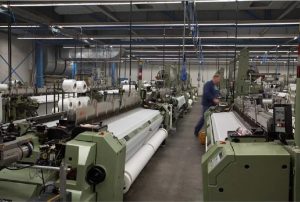
Sail Fabric
Choosing the right fabric in the first place is probably the most important decision in getting the best from your sails. Kemp Sails put sail fabric choice right at the forefront of our discussions with potential customers and we are always happy to supply samples of the fabrics we are recommending. It’s fair to say that in recent years we would send fabric swatches out as a matter of course with all our quotes – though with the email revolution and rising postage costs we now tend to attach fabric data for speed – but please don’t hesitate to ask!
In fact that is the most important sentiment we could make here – simply to ‘ask us!’ We are concerned that this is an area where we are the ‘experts’ and our customers should make sure they get ‘best advice’ and not feel that they should be experts or have a lot of technical understanding themselves – above all Kemp Sail want our customers to feel that they were able to make an informed decision, so please talk to us….
Who makes Sail fabric?
There are four mainstream Sailcloth suppliers around (there are others) but these are Dimension Polyant (German), Contender Sailcloth (Dutch), Bainbridge International (UK/American) and Challenge Sailcloth (American). All of the above have websites with more detailed information on their fabrics and in many cases data sheets on their specific styles.
Largely speaking we stick to using materials from these suppliers, as they hold stocks and they produce consistent material which is reliable in quality; ie. flatness, dimensional stability, free from structural weaving flaws, and help provide technical backup and R&D development. There are more fabrics becoming available from Asia and the Far East now but these Main companies have specialised in their fabrics and will stand by the products if there ever any problems, so we prefer to stick with them.
So, what are the main types of fabric?
For most modern cruising yachts there are essentially two categories of sail fabrics:
- Those suitable for the fore/aft sails or white sails, (Mainsails, Genoas etc.) and,
- Those materials for Downwind Sails. (for Spinnakers & Cruising Chutes etc)
Downwind Sail Fabric is relatively easy to explain, so we’ll do that first.
Most of us have sailed with a Spinnaker or Cruising Chute at some time and you may remember the sail is flying unsupported from the spars, hence occasionally the sail will fill and collapse.
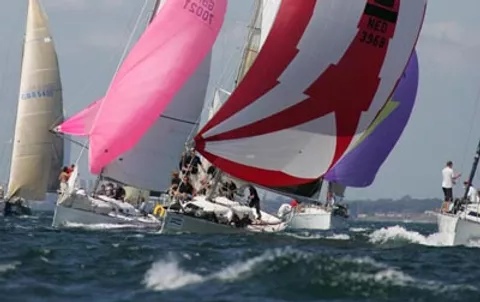
Often this can be with quite a ‘pop’ and for this reason, as Sailmakers we want the sail to absorb some of that ‘shock’ and so we choose a slightly forgiving fabric.
So, we usually choose Nylon as it has a little more elasticity as a fibre and it’s usually woven in a form these days that we call Ripstop. Which means it has a square weave pattern that is formed by periodically twisting a few fibres together to increase tear strength, or occasionally by adding a larger fibre into the weave at even spaces.
So, Nylon Downwind sail fabric is very light, a little stretchy and surprisingly strong… In the UK the fabric weight is usually expressed firstly within a generic weight category – such as ‘¾ ounce’, or ‘1½ ounce’ and then as a style name with a more detailed weight that may well now be in grams.
Most importantly these materials are available in attractive colours so you can personalise your sail and keep the crew entertained!
Either of the weight categories will ‘fly’ in quite light winds even as smaller sails – but often the heavier wind range sails (or more All-Purpose Sails) will be in the 1½ ounce weight range. Because the lightest material comes at the expense of some durability and tear resistance if the sail handling isn’t quite as slick as you had planned for!
So, in cruising sails usually ¾ ounce is good for Light Symmetrical shaped Spinnakers and 1½ ounce is best for Heavy Symmetrical shaped Spinnakers, Asymmetric and Cruising Chutes.
There are also heavier weights of Downwind sail fabrics for bigger yachts and for racing sails there are lighter ones..some are more heavily coated with a stabilising resin to make a harder ‘crispier’ feel and support that unsupported flying sail shape….but this is meant as a simple layman’s guide and so we’ll move on to the Mainsail and Genoa fabrics. If you would like some more detailed information then you know what to do! …just drop us an enquiry note, or call…
Upwind Sail Fabrics
. . . are more complex and since there are more variations in weight and factors of construction to consider we’ll again try to make a Layman’s guide. More detailed or specific questions can be answered individually….
Laminate or Woven Sailcloth?
It’s well accepted that Woven Sailcloth lasts longer that Laminated Sailcloth in terms if its ‘Terminal Durability’ i.e. how long it stays together in one piece…but that’s not the whole story – there is a ‘Performance Durability’ aspect, that is how long the sail performs acceptably as an efficient method of propulsion. After all, we don’t usually wear our clothes until they fall off us – So, when a sail has stretched beyond an acceptable point that is the end of its Performance life. To examine what this is for each fabric option we need to understand what each option actually is.
What is Woven Sailcloth?
Weaving looms have made enormous technical leaps in speed and consistency but the basic Sailcloth weaving principle remains the same since the first ever looms. Woven styles are made up from differing weights of finished fabric and the fibre size construction determines the weight and stability (read stretch resistance!) of the finished material.
The more tightly woven the material, the more stable it will be and thus the longer your sails will hold the shape that you sail maker designed them to have. So, to understand what aspects make the difference….
Very basically, what happens is that a huge rack of thread spools are wound onto a big straight pole called a ‘Beam’. These form the fibres that run the length of the finished roll and they are called the Warp threads. Thus the Warp Beam is fundamentally at the heart of any woven fabric style and often one Warp beam will be used for creating several styles or weights of material. The quality of the fibre used for this beam is determined by its tenacity (strength) and it’s pre-weaving preparation.
The Warp beam fibres are tied-in or drawn into the weaving loom and are pulled through under some tension. There are four principle operations:
Warp Fibres are pulled alternately up and down which is called ‘shedding’, i.e. creating a ‘shed’ or tunnel through which:
The Weft/Fill yarn (often on a shuttle) passes across. Inserting the Weft/Fill yarn is called ‘Picking’.
‘Beating up’ which is packing the Fill yarn in tightly against the Warp Yarns which held (wrapped) around it.
‘Taking up’ is the newly woven material process of winding onto the new cloth beam.
Now we have a roll of raw cloth roll that is woven as tightly as the size of the fibres allow and as the loom could pack it all in…..(so you can see how there can be differences already in here…) Small fibres will pack in more densely, but would take longer to weave and as always “time = money”. Bigger fibres are also stronger, but they don’t weave in so tightly.
The natural cloth at this stage would be very ‘soft’ and stretchy – particularly on the ‘bias’- and to see roughly what it looks like at this stage you may find some in some yacht sails – usually if you have a ‘lens foot’, which is soft stretchy panel in the very bottom of some sails where it attaches to the boom.
So the ‘Bias’ is the 45-degree angle that lies between the Warp thread and the Fill/Weft threads. If you pull most non-sailcloth woven fabrics in this way you will see a surprising result and a big crease! If that happens with your sail it’s not good!
Since sail loads go all over the place (especially when you part Furl or Reef them) we need this bias to be stabilised and locked up. Hence, the natural cloth will have to undergo at least two more basic processes (and often several more in terms and washing and dying to become usable Woven Sailcloth.
- Heat Setting (which is essentially shrinking it, by passing it between two super-heated rollers).
- Coating or Impregnating it with a resin, to ‘glue’ all the fibres in place.
The fabric will of course be rolled onto smaller more manageable rolls and is inspected and any flaws broken fibres marked or cut out.
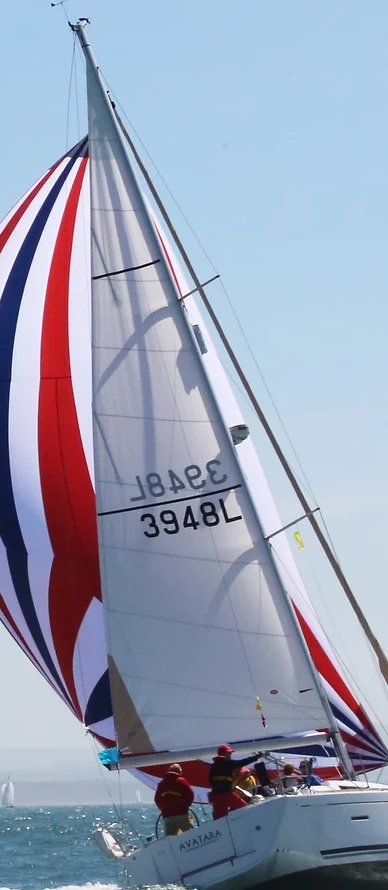
What type of fibres are used?
So, we can see that any woven material that Kemp Sails recommends for you will be judged on its fibre quality for consistency, strength and shrinkage qualities, and also the way it wears in UV as lesser quality fibres degrade more quickly in the harsh UV light.
Over the years Sailcloth manufacturers have tried all the fibres names that you have ever heard of and the best combination of strong performance (taking into account the basic cost), wear longevity in both UV light and in flex durability, and fibre shrinkage (which helps) and water absorption (which doesn’t!) is actually Polyester! It isn’t necessarily the best fibre in any one particular aspect – but it’s by far the best right across the board…..So usually we recommend a fabric that employs a top quality, High Tenacity Polyester.
Stabilising the Weave.
Then we look at the weave quality and the stability that is achieved in the fabric before it is fluttered (a simulated test of the wear sailcloth gets) and then afterwards. This tells us how well the fabric can rely on its initial weave quality and also how much it relies on the subsequent resin impregnation to hold it all together.
Remember resin coating isn’t necessarily a bad thing, some top quality racing woven fabrics are heavily coated and stiff to feel, so this aspect is often wrongly stated…it’s just important that the resin impregnation is not the ONLY thing holding it together!
To judge and compare a fabric feel it yourself in your fingers and crinkle it up in your hand – that’ll give you a good indication of how much coating is on there – some fabrics actually ‘marble’ where the creases are, so you can tell if you are being told a fabric has no coating and then go and decide for yourself!
Some fabrics have a Ripstop weave incorporated into them. This can be a very good thing such as in D/P’s Square range, adding tear strength and stability, but it depends how it’s woven (the construction differences are explained in the Nylon section). It’s not so good if it determines how the fabric ages and if it frays excessively along the fibres – you can have too much of a good thing.
How does the Sail Aspect Ratio affect the choice of fabric?
Finally, the construction of a woven fabric has to lend itself towards the Aspect Ratio of a sail. High aspect ratios sails are tall and thin and the loads run closer together up the Luff and Leach edges. Fabrics for these sails can be stronger in the Weft/Fill and so have more fibres, or bigger fibres or even High Modulus Fibres included such as Vectron cloth (using Vectran fibre) or Hydra Net (using Dyneema/Spectra fibres) to assist the performance.
Low Aspect Sails (long footed with a shorter hoist) typically warrant a more ‘balanced’ construction and a more evenly spread construction. However, keep in mind that using fibres of the same size in both Warp & Fill is likely to make a very unstable initial weave set because the Warp won’t wrap around or ‘pack’ so tightly into the weave. For this reason, a lot of fabric ranges are designed to be the best they can be in all applications – and the Sailmaker is left to orientate the panel’s angle in the sail to suit the fabric and gain the best performance.
Radial or Cross-Cut?
Having now mentioned the concept of sail panel orientation, it is possible to align the Fill fibres which we know are the ‘straightest’ fibres within the weave, with the principle Leech loads, and it means that the loads along the Foot are then catered for by the other main fibre direction (the Warp). If the Fabric has a good bias stability, then this should make a good sail configuration and it’s called a Cross-Cut layout. The material is used very efficiently like this and the panel width (typically around 1.4m wide) means there is ample option to build the shape progressively into the sail, as this ‘shaping’ is introduced at each seam joint.
The other common method (there are others – but this covers most modern sails) of panel layout is Radial cutting and Bi-Radials radiate from the Two, (Head and Clew) corners, hence the name ‘Bi-Radial’…the Tri-Radial’s are also Radiating out from the Third (Tack) corner.
The idea here is that the Warp (Long) fibres are laid in the direction of the loads in longer and thinner panels that are all fanning out from each corner. Technically, this is correct, however, we also know that the woven fabrics are narrow in weave width (typically 1.4m) because the Fill shuttle can only travel across a short ‘shed’ distance….hence we must use the Warp fibres to get a panel of sufficient length.
The drawback here is that of the two fibres the Warp is typically smaller so that it can wrap around the Fill fibre tightly to get that all-important weave stability. So if we load this Warp fibre up heavily it will then naturally want to straighten out and eventually will give us corrugations from the corners rather than strong smooth sails.
One other problem for Radial sails is that when we come to cut the panels out of the rolled cloth we use a computer and ‘nest’ them in together (like Tetris!) aligning the fibres with the long edges of the panels…..however, this does mean a lot more fabric wastage and that has a price.
In summary, to make a Radial sail in a woven fabric you MUST use a very good sail fabric with a balanced performance in Warp & Fill (e.g. D/P’s Square fabric range, or Contender’s Radial Wide).
Better still, if you are set on a Radial layout, use a Strong Warped Radial fabric, such as Hydra Net Radial, or just forget about wovens and use a
Laminate Sailcloth
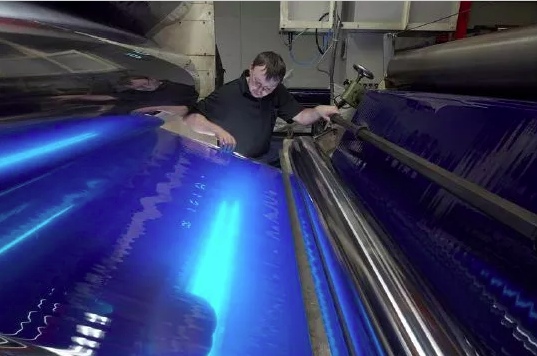 Laminates were invented as a way to avoid the bias instability of woven cloth sailcloth and also to avoid the Warp ‘crimp’ (bending) that comes with ‘Shedding and Packing’ the weave.
Laminates were invented as a way to avoid the bias instability of woven cloth sailcloth and also to avoid the Warp ‘crimp’ (bending) that comes with ‘Shedding and Packing’ the weave.
With Laminates, instead of coating and impregnating the weave with resin, the early idea was to simply laminate (bond) one or more sheets of Mylar film onto a side and achieve the same result.
Quickly it was identified that the strength coming from the weave could be dramatically improved if it wasn’t woven and if the fibres giving the fabric it’s strength were actually laid straight and so ‘scrims’ were created, holding the fibres in a grid (you can usually see those easily and they give away the fabric as a laminate construction).
The next ‘Eureka’ moment was that you could make Laminates even stronger and lighter and thus faster in sails, by using a fibre that is a lot stronger than Polyester! This opens up a whole new subject – so here let us suffice to say that most laminates used for racing are made with High Modulus fibre Scrims, such as Kevlar and Carbon fibre, or Pentex (which is a ‘posh’ Polyester). And the determinate factor is usually cost.
For Cruising Laminates the issue of durability is again a factor, for inevitably higher mileage sailing is involved, and so we quickly revert to Polyester again or a mix of Polyester and sometimes Spectra /Dyneema (though this is notably hard to glue and bond for enough durability).
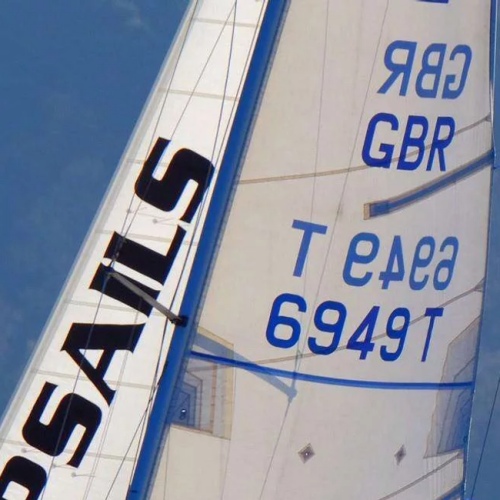
Laminates have the simple drawback that they don’t stand the flex fatigue that sails suffer as well as woven materials – so going full circle they have a better ‘performance life’, but a far shorter ‘terminal lifespan’ and they also suffer from mildew where the layers generate a perfect environment for Mildew spores to grow. Mould grows on things (and inside too if it can get there) so unfortunately even new sails can quickly develop Mildew marks from airborne dirt and pollutants and there is precious little that can be done to prevent it.
Kemp Sails recommend if you are thinking about laminates, that you ask yourself if you are a frequent club racing sailor, or if the sailcloth shape performance is that ‘critical’ for you. If it is? then you get a laminate and look after it carefully and enjoy it whilst it lasts – by all means talk to us about it because there are things we can do to help it last longer and definitely things that yo can do to help it last longer.
If you are concerned that laminates won’t live up to your expectations of longevity, or that you want to cross seas and oceans – Or more likely, your boat budget simply won’t stand to replace the laminates when they are in great shape still but now have holes worn all over them…
Hy-Brid woven fabrics
Do not fear – the top spec Hy-Brid wovens are superb and they have come along way in the last few years. Kemp Sails probably recommend more Vektran (from D/P and Contender) and Hydra Net (from D/P) than ever before nowadays, and if they fit in the boat’s budget – we rarely hear anything other than positive comments about them subsequently.
This was Kemp Sail’s Guide to Choosing Sailcloth Fabric and we haven’t covered every aspect or angle – because as you can now appreciate, it’s quite a complex subject. But you will hopefully have gained an insight into what to look for and why we may have suggested the material that we have. Ultimately, we need to look at the sail you need, the boat you have and the sailing aspirations you are planning for – then its time to call us, or come and see us for that chat!




